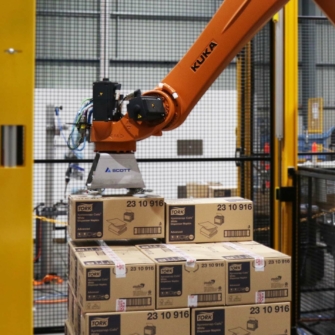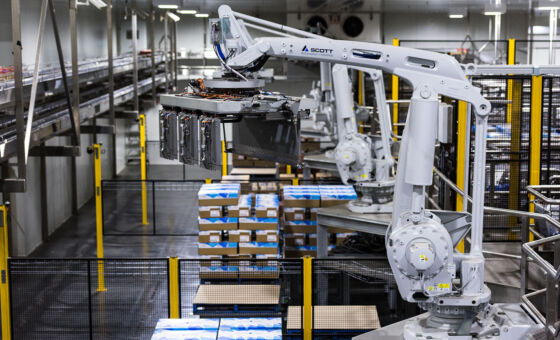Select your region / language
Five Benefits of Robotic Palletising
Used globally, robotic palletisers have many benefits that are helping to revolutionise the manufacturing industry. These benefits help to create a safer, more efficient, and cost-effective work environment that can be used for large or small-scale warehouse production.

Used globally, robotic palletisers replace the physical and repetitive actions needed by workers and are helping to revolutionise the manufacturing industry. Movements that require the stacking of items, such as boxes, cartons, and bags, can be quickly and efficiently programmed into a robotic palletiser, improving workplace safety and the morale of workers who will no longer need to be focused on menial tasks. With an ever-growing need for automation, robotic palletisers are a reliable addition to any warehouse production area, with many benefits that can help further your business.

Safer Working Environment
The most common injuries in a warehouse-based environment are those created from repetitive tasks, which can result in time away from work or add to employees leaving the workforce. Robotic palletising can assist in alleviating the risks involved in such tasks, removing the manual handling component, and reducing employee exposure to heavy loads and the repetitive tasks that allow these injuries to occur.
Factors contributing to these injuries, such as fatigue and distraction, are also removed. Robotic palletisers can run with minimal supervision and do not require stoppages to continue functioning. This can be at a consistent speed so that deadlines can be met without increasing the risk due to overworked or tired employees. Removing employees from the menial and repetitive tasks that are now performed by the robotic palletising system allows workers to be instead placed into value-adding jobs, increasing an employee’s outlook of their role within a business, their general morale and helping with business retention.

Multiple Production Lines and On-time Production
Robotic palletisers are modular by design, meaning many variations can be made to suit your business and product range. A system can be used to palletise multiple products where the system is taught to recognise each product and organise a set pattern accordingly, quickly and easily switching programs between products and pallet plans as required. Robotic palletising also saves space, and reduced footprint options are available to provide automated palletising options for producers of all sizes.
Even with possible product variations, robotic palletising allows for predictable output so there is no need for guesswork or estimations with delivery times, offering security with consistent performance. It removes the risk of bottlenecks and improves the overall stability of a packed pallet, which in turn, drastically increases operational efficiencies, creating a consistent and reliable throughput.

Easy To Use
Robotics is one of the fastest-growing industries in the world, and improvements in ease of use have been a focus and a large part of its growth. Robotic palletising is designed to be simple to use; a set number of stock is designed into a pattern, and the pattern is programmed into the robotic arm so that pattern can be carried out. Once a pallet is complete, the robot can quickly move on to the next pallet with another robot or human worker's assistance. These patterns can be applied to a wide product range, including crates, boxes, and bags, meaning robotic palletising can be extremely diverse and effective for both small and large-scale manufacturers.
Learn More About Robot Palletisers
Scott´s robot palletisers provide the flexibility to palletise single or multiple production lines simultaneously, markedly increasing output and decreasing overhead costs. They are available with a range of various grippers, enabling them also to pick up empty pallets and interlayer sheets.





